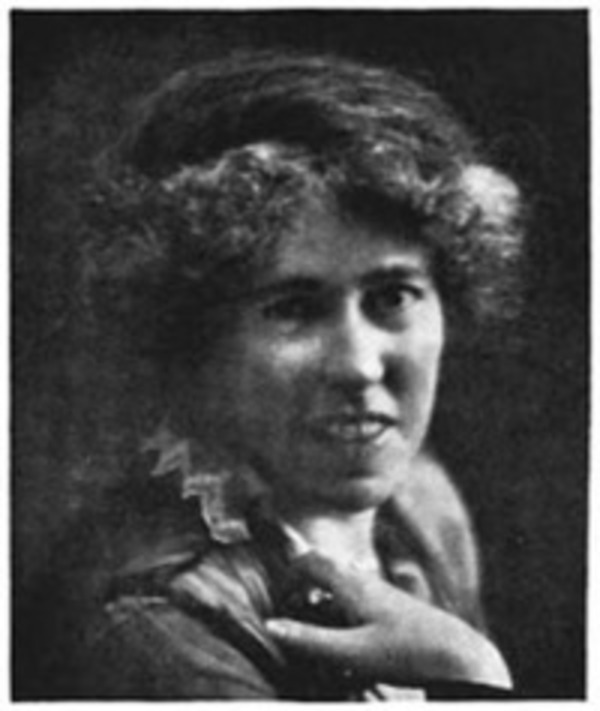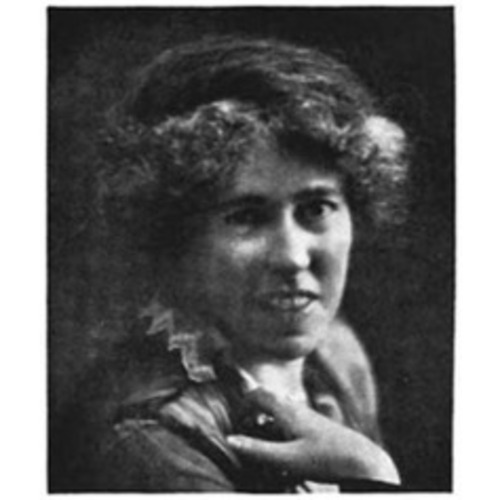
Source: Link
BLACKBURN, VICTORIA GRACE, journalist and author; b. 17 April 1865 at Quebec, fifth daughter of Josiah Blackburn* and Emma Jane Delamere; d. unmarried 4 March 1928 in London, Ont.
Grace Blackburn was born in Quebec City, possibly when her father, the publisher of the London Free Press, was there on political or newspaper business. After schooling in Hellmuth Ladies’ College in London, she taught in the United States in the 1890s. She had begun writing in 1894 for the Free Press, then under the direction of her brother Walter Josiah, and in 1900 she became its literary and drama critic. She spent some time in New York studying criticism and in 1906–10 was in Europe with her sisters, immersing herself in cultural affairs. In 1918 she assumed the position of assistant managing editor, which she would hold until 1928. For three decades she was a leading figure in the cultural life of London. Her manner of commentary ranged from imperiousness, which she could turn on London (a city that “has not believed sufficiently in herself”), to firm appreciation, of such masterworks as Romney’s paintings of Emma Hart, Wordsworth’s poetry, and Venice’s ducal palace.
Although nepotism can be reasonably inferred from Blackburn’s career at the Free Press – her sister Susan May was also a staffer and a shareholder – a fair assessment of her output (often under the name Fanfan) would have to acknowledge her productivity and intellectualism. In addition to her criticism, she contributed essays, travelogues, editorials, and poems. The demands of daily journalism imposed some limits on her literary effort and gave occasion to such awkward items in the Free Press as her approving (but now embarrassing) description of Helen Keller in 1913 as the “High Priestess of the Blind” and her farewell in 1924 to Middlesex County writer Peter Gilchrist McArthur as “a son of the soil and a gentleman; such a gentleman as perhaps only a son of the soil can be. The immediate soil of which he was the son, is the soil of Canada.” In a later account of Blackburn, Professor James Albert Spenceley of London credits her with stronger literary and lyrical sensibilities.
Blackburn produced, in addition to her work for the Free Press, dozens of poems, two known plays, and a novel. From her verse, some of it superficial, certain typical devices and themes emerge: sudden shifts from satire to tragedy, a gift for aphorisms, and a fondness for archaic language, exotic locales (Renaissance France for example), tortured aesthetes, and doomed love. Her two one-act plays, preserved in the University of Western Ontario Archives, are “Seal of confession,” a drama set in a priest’s home in France, and “The little gray,” a farce set in a New York dress shop. The former explores Blackburn’s motif of noble self-sacrifice; the latter shows her love of dialect, humour, and satire aimed at her own class; both are full of clumsy staging.
Blackburn’s writing about World War I is superior to her other work. In “Christ in Flanders,” one of the four poems by her included in John William Garvin*’s Canadian poems of the Great War (Toronto, 1918), the wounds of a female survivor resemble those of the crucified Christ. Her most successful endeavour, posthumously published, is The man child (Ottawa, 1930), which deserves renewed attention. Written about 1916, it begins in a fictionalized version of London and area during the 1890s and moves to the trenches of France, where the young Canadian hero, Jack Winchester, will be killed. Like many Canadian novels on the war, it explores the “right stuff” among volunteers and, resorting to popular symbolism, likens Canada to David fighting the Teutonic Goliath. The novel gathers force as the trials and triumphs of Jack’s widowed mother give way to the imminence of conflict. Blackburn’s love of drama is apparent in the way her characters articulate different points of view over the gathering storm. Striking too is the realization that her most intelligent characters appear, at first, appalled at the thought of England fighting its natural ally, Germany, and siding with dissolute France. Once the war begins, Jack and a friend leave medical school, whose dean plays a role in the story, to enlist. When the novel shifts to an epistolary mode, Jack’s friend sends a letter home asking, “Do you remember that poem of Walt Whitman’s the Dean is so fond of,” and quoting from Whitman’s “The compost.” This may have been unusual content for a letter from the front but not for a novel set in London (where Richard Maurice Bucke*’s enthusiasm for Whitman was well known) and written by Blackburn (who gave a paper in 1916 comparing Whitman to Rodin). Following a scene with the two youths lost and under fire in No Man’s Land, the closing line (“What rites! What obsequies!”) sounds a Whitmanesque note. One of Blackburn’s great friends, fellow Anglican and poet Robert Winkworth Norwood*, appears in the novel thinly disguised as the Reverend Norman Brooks. Like him, Norwood, the rector of Cronyn Memorial Church in London from 1912 to 1917, was a modern thinker and dynamic preacher who saw the war as an opportunity for everlasting peace.
Grace Blackburn’s determination to honour Canada’s war dead led her to support the proposed erection near London of a monument of perpetual light. Although her backing was not sufficient to raise the $10,000 it would have cost, she was involved in a more modest memorial completed in 1926. Tall, charming, and full of humour, she was active in London’s theatre and many clubs and associations; she was a founder in 1910 of the local Women’s Canadian Club and its president in 1918–19, and in 1921–23 she served as president of the London Women’s Press Club. It is difficult from a modern viewpoint not to feel some scepticism about the grand claims made for Blackburn in her lifetime, but her intellect and commentary were much lauded. In 1916 J. W. Garvin praised her in an anthology as “a writer with a large brain and a big, warm heart: a twentieth century thinker, with the individuality of original thought and expression; a poet just beginning to realize her gift.” In 1924 novelist Arthur John Arbuthnott Stringer recognized her sharp critical sense. Such approval continued after her death. In December 1930 the London Advertiser (owned by the Blackburns from 1926) quoted the estimate of Canadian Homes and Gardens (Toronto) that The man child was “a very beautiful contribution to Canadian literature and perhaps to literature generally.”
One of the few traces of Blackburn’s contributions in London is the historical plaque outside the home at 652 Talbot Street where she lived for 16 years with three of her sisters. As a Canadian woman in the early 20th-century newspaper business who produced one good, interesting novel and had a strong command of vocabulary, Grace Blackburn may find new friends in this century.
Victoria Grace Blackburn is the author of Fanfan’s poetry (the collected poetical works of Victoria Grace Blackburn), ed. E. H. Jones (London, Ont., 1967).
AO, RG 22-321, no.18961. St Paul’s Anglican Cathedral (London), RBMB. Univ. of Western Ont. Arch., J. J. Talman Regional Coll. (London), Blackburn fonds, writings of Victoria Grace Blackburn. London Advertiser, 20 Dec. 1930. London Free Press, 22 Feb. 1913, 29 Oct. 1924, 3 Feb. 2002. Canadian poets, ed. J. W. Garvin (Toronto, 1916), 383–88. Nancy Geddes Poole, The art of London, 1830–1980 (London, 1984). M. [L.] Lang, Women who made the news: female journalists in Canada, 1880–1945 (Montreal and Kingston, Ont., 1999). Flora MacDonald [Merrill (Denison)], “Miss Grace Blackburn,” Sunset of Bon Echo (Toronto), 1 (March 1916–April/May 1920), no.3: 19. Michael Nolan, Walter J. Blackburn, a man for all media (Toronto, 1989). Standard dict. of Canadian biog. (Roberts and Tunnell). F. B. Ware, History of Cronyn Memorial Church, London, Ontario, 1873–1949 ([St Thomas, Ont., 1949]). Who’s who in Canada, 1922.
Cite This Article
James Stewart Reaney, “BLACKBURN, VICTORIA GRACE,” in Dictionary of Canadian Biography, vol. 15, University of Toronto/Université Laval, 2003–, accessed December 15, 2025, https://www.biographi.ca/en/bio/blackburn_victoria_grace_15E.html.
The citation above shows the format for footnotes and endnotes according to the Chicago manual of style (16th edition). Information to be used in other citation formats:
| Permalink: | https://www.biographi.ca/en/bio/blackburn_victoria_grace_15E.html |
| Author of Article: | James Stewart Reaney |
| Title of Article: | BLACKBURN, VICTORIA GRACE |
| Publication Name: | Dictionary of Canadian Biography, vol. 15 |
| Publisher: | University of Toronto/Université Laval |
| Year of publication: | 2005 |
| Year of revision: | 2005 |
| Access Date: | December 15, 2025 |



